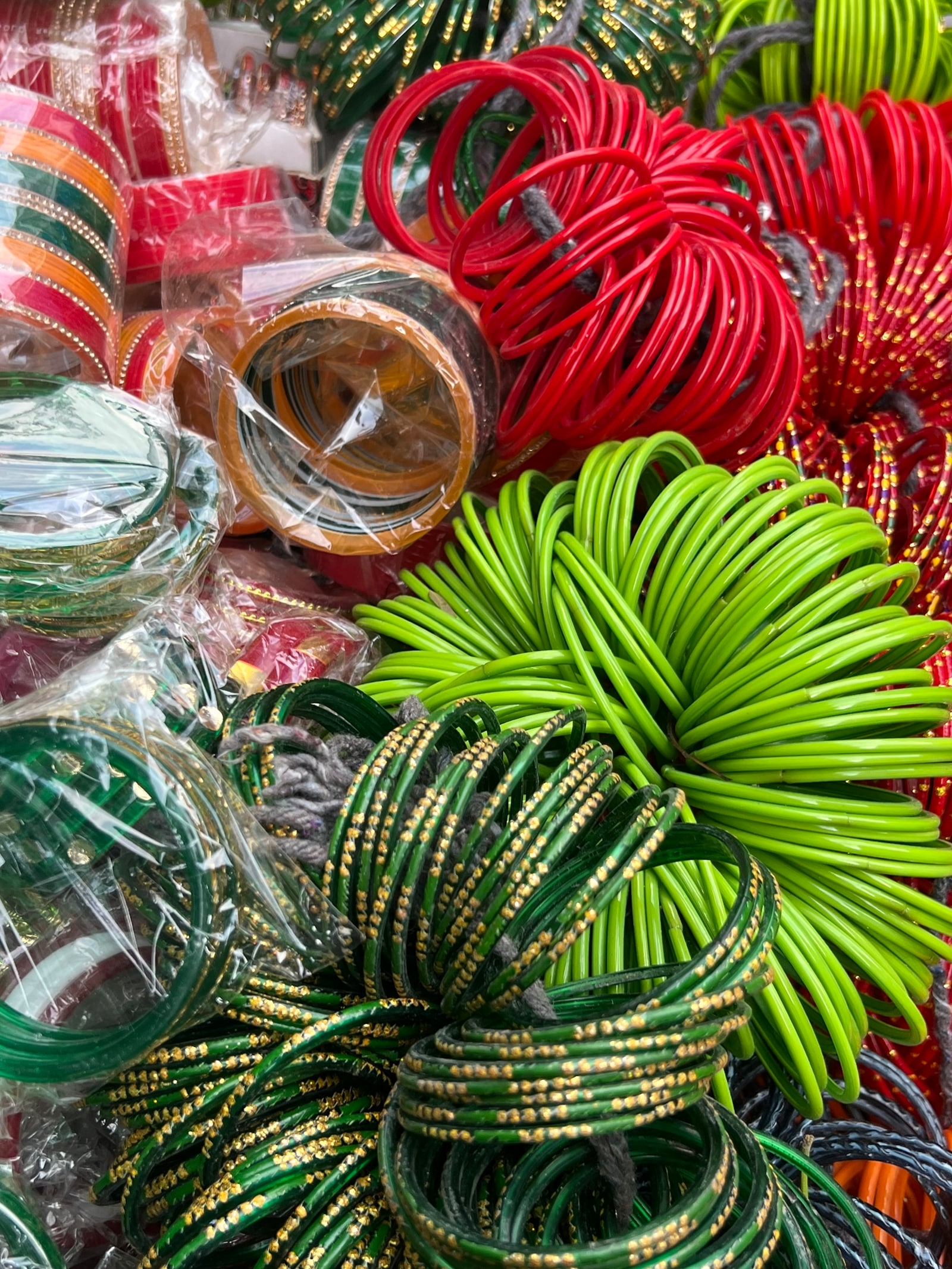As the mango season fades, the saawan showers ease the parched earth and bring relief from the summer’s heat. Vendors bid farewell to the last of the Langda mangoes and begin stocking their carts with fresh black jamuns, pears, and apples. Vegetable sellers stock their carts with monsoon produce like the white and pink karondas – sour berries that fruit during this time – alongside tender green bhuttas, junglee karelas (kakodas), and sweet nimbolis that fall from neem trees after the rains.
The lush greens of saawan have long inspired celebration through tradition and festivity. Fields and landscapes are awash with freshly bathed greenery, while bustling markets echo the season’s colours as flower vendors begin selling freshly harvested pink oleander, rose, and the sacred lotus for prayers. Streets fill with bangle stalls, mehendi artists, and halwais making ghiya barfi and ghevar.
Shops and boutiques display green suits, hari choodiyaan (green bangles), red dupattas, and cosmetics that make up solah shringaar to mark the arrival of Hariyali Teej at this time. Rakhis – designer threads, chocolate rakhis, rakhi thali sets – line the shelves along with hampers of besan laddoos, many of which will make their way around the world.
This seasonal abundance also marks worship of primarily Shiva, Parvati, and, in some parts, Krishna. Devotees offer bel leaves, dhatura, and aak flowers during ‘saawan somvaar,’ all of which naturally bloom at this time. The fragrance of mogra hangs in the air; rooftops and balconies are draped in madhumalti. Aparajita, lilies, and nine o’clock flowers bloom in vivid hues. Pomegranate trees burst into resplendent red and orange flowers, while kaner trees draw bees to their yellow and white blossoms. In ponds and lakes, the lotus rises, connecting nature, divinity, and abundance.
 Vegetable sellers stock their carts with monsoon produce like the white and pink karondas – sour berries that fruit during this time. (Photo: Swasti Pachauri)
Vegetable sellers stock their carts with monsoon produce like the white and pink karondas – sour berries that fruit during this time. (Photo: Swasti Pachauri)
This is also the time when lush green Neem trees serve as anchors for jhoolas (swings), where women and children sway in joy. These swings are central to Jhulan Purnima, a festival dedicated to Radha and Krishna’s playful bond. Decorated with leaves, ropes and bright seasonal flowers, jhoolas represent joy, love, and the life-affirming rhythm of the rains. In regions where Jhulan Purnima is observed, women sing saawan ke geet. Bansuri (flute) sellers appear on the roadside, often selling Krishna costumes and accessories, signalling the approach of Janmashtami.
The Saawan jhoola has found visual expression in folk art across India. Madhubani paintings capture women on swings, Radha-Krishna on ornate jhoolas. Similarly, many forms of Indian art has long captured the
spirit of Saawan and the spirit of the monsoon through the eternal tales of Radha Krishna. From the Bhagavata Purana to Gita Govinda, scriptures have inspired such artistic depictions. Pahari miniatures from the Basohli, Guler, and Kangra schools, as well as Baramasa and Ragamala miniatures from Rajasthan, depict various themes that celebrate the essence of Radha Krishna and the different aspects of the monsoon season.
Story continues below this ad
 Shops and boutiques display green suits, green bangles, red dupattas, and cosmetics that make up solah shringaar to mark the arrival of Hariyali Teej at this time. (Photo: Swasti Pachauri)
Shops and boutiques display green suits, green bangles, red dupattas, and cosmetics that make up solah shringaar to mark the arrival of Hariyali Teej at this time. (Photo: Swasti Pachauri)
Pichwai paintings from Nathdwara show Krishna amidst Kamal Talai, lotus-filled ponds in bloom. Phad paintings, Thanjavur art, Kalighat paintings, Madhubani and Gond art, all echo the themes of Saawan – swings, dancing peacocks, blooming trees, festive moments. Odisha’s Pattachitra tradition, particularly around Lord Jagannath, is also rich in Saawan symbolism.
Language itself seems to change during Saawan, with words like barkha, bahaar, varsha, megha, and malhaar woven into daily conversations. The monsoon finds its rhythm in music and popular culture. Shubha Mudgal’s 1999 classic Ab ke saawan aise barse captured the season’s mood in a contemporary pop idiom. Earlier, Badal paani barsaye from the 1997 film Saaz added to the canon.
In classical Hindustani music, Raag Miya Malhaar is steeped in the sound and soul of the rains. Folk traditions like Kajri and Saawani songs explore themes of love, longing, and nature. Bollywood continues to revisit Saawan through generations: Saawan ka mahina (1967), Bole re papihara (1971), Rim jhim gire saawan (1979), Morni baagan mein (1991), Barso re megha (2006), each a reflection of how the season lives on in sound.
Saawan also arrives with culinary signatures. As soon as the first showers fall, mithai shops begin stocking ghevar, a disc-shaped dessert topped with cream, saffron, dry fruits, silver leaf, and rose petals. Associated with Teej, Rakhi, and Saawan festivities, it’s especially popular in Rajasthan and Braj Bhoomi. Newer versions – like chocolate ghevar – now cater to modern tastes. Even during the COVID-19 lockdown, ghevar sales continued steadily due to its deep cultural link to the season.
Story continues below this ad
Other Saawan sweets include lauki ki barfi, whose green colour echoes the landscape, and malpua – a deep-fried dessert soaked in syrup, sometimes garnished with almonds and saffron. These are often offered as prasad alongside traditional kheer and phirni served during bhandaras. A spiced green dhaniya panjiri is specially made for Janmashtami, which arrives after Saawan, this year.
Saawan celebrates nature’s abundance and speaks in the language of everyday ecology, rooted in seasonal produce. Its essence has been timelessly preserved and celebrated through art, music, literature, and culture.

